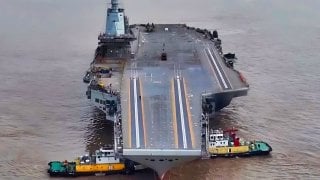Does China Want 3 Aircraft Carriers to Conquer Taiwan?
The Chinese Communist Party (CCP) has long viewed Taiwan as a breakaway province, despite never having governed the self-ruling island. Recent reports suggest that China's People's Liberation Army Navy (PLAN) may employ a strategy involving three aircraft carriers in an anti-access/area denial (A2/AD) approach to deter foreign intervention during a potential invasion of Taiwan.
Summary and Key Points You Need to Know: The Chinese Communist Party (CCP) has long viewed Taiwan as a breakaway province, despite never having governed the self-ruling island. Recent reports suggest that China's People's Liberation Army Navy (PLAN) may employ a strategy involving three aircraft carriers in an anti-access/area denial (A2/AD) approach to deter foreign intervention during a potential invasion of Taiwan.
-These carriers, supported by long-range missiles, would be positioned east of Taiwan in the Philippine Sea, out of range of Taiwan's anti-ship missiles.
-However, analysts argue that despite PLAN's growing capabilities, a successful invasion of Taiwan remains highly challenging.
-Taiwan's defenses, combined with potential U.S. and allied intervention, could severely complicate China's plans, making a quick victory unlikely and sustainable resupply for China's forces difficult.
Three Aircraft Carriers to Conquer Taiwan?
The Chinese Communist Party (CCP) has never actually controlled Taiwan, which is a self-ruling island that was under Japanese occupation until the end of the Second World War when it was then returned to Nationalist Chinese control. Yet, Beijing maintains that it is a breakaway province that will be returned to mainland rule and by force if necessary.
Taking the island, which has a mountainous jungle interior that not even the occupying Japanese never fully subjugated during World War II. Needless to say, it would be difficult, as the People's Liberation Army Navy (PLAN) would have to mount numerous amphibious landings – crossing the Taiwan Straits.
It is now speculated that Beijing's efforts to build aircraft carriers while countering the U.S. Navy's fleet of flattops would be key to such a plan.
According to a new report from the Mainland Affairs Council (MAC), cited by the Taipei Times on Tuesday, China's "Taiwan Strategy" may call for the use of three carriers, which would engage in a strategy of anti-access/area denial (A2/AD) around the island.
"In the quarterly report, the council cited declassified documents from the Ministry of National Defense that categorized China's carriers as a threat if used for A2/AD, and said that China might coordinate its naval, air force, and rocket force capabilities to operate beyond the first island chain and deter foreign forces from getting involved in a conflict involving Taiwan," the Taipei Times news piece laid out.
Three Carrier Strategy
The PLAN is currently conducting sea tests on its third – and second domestically-built – aircraft carrier, the Type 003 Fujian, while efforts have been made to further improve the Type 001 Liaoning and Type 002 Shandong. According to the MAC report, the carriers wouldn't be employed in the invasion and instead could be positioned in the Philippine Sea, well outside of Taiwan's Xiangfeng missiles, which have a range of 200km to 250km.
The carriers would support PLAN forces east of the self-ruling island to serve as a deterrent to foreign aid. The carriers and other warships would be supported by China's so-called "carrier killer" DF-21D and DF-26B anti-ship missiles that could be positioned to strike any approaching U.S. fleet.

"The Chinese People's Liberation Army (PLA) Rocket Force would deploy medium and long-range conventional ground-attack and anti-ship ballistic missiles, and cruise missiles to foreign forces in the area between the first and second island chains," the report added.
A War of Attrition
While the report warned what Taiwan might face, Institute for National Defense and Security Research fellow Su Tzu-yun highlighted that even as the PLAN is being transformed into a "blue water navy," it may not be enough for it to successfully invade Taiwan and establish a beachhead that could lead to control of the island.
Taipei has anti-ship missiles that could be employed against an approaching armada, while the Taiwanese Navy would need to rely on submarines to counter the PLAN's carriers – further emphasizing the need for the self-ruling island nation to continue the development and production of its domestically-built submarines.
Su further noted that any attempt to employ an A2/AD strategy would require that the carriers would be "sandwiched" between Taiwan and a U.S. fleet from Hawaii and Guam.
"Thoughts to the contrary are simply wishful thinking on the part of the Chinese," the Taiwanese analyst added.
The PLAN would need to see quick success, as its carriers and other warships would need supplies within just a week or two.
"Since the passage of supply ships through the Bashi Channel or Miyako Strait would be too dangerous, and China has no overseas bases, supplying the carriers would be impossible," explained Su. "Any advantage brought by the carriers would be quickly lost."
It is also unclear if the MAC report lays out what role South Korea, Japan, the Philippines, and Australia – not to mention India – might react if Beijing were to mount an attack on Taiwan. It is unlikely that some of Taipei's allies and regional partners would simply sit by, while other regional rivals of Beijing might see it as an opportunity to gain an upper hand in the South China Sea and far beyond.
Author Experience and Expertise: Peter Suciu
Peter Suciu is a Michigan-based writer. He has contributed to more than four dozen magazines, newspapers, and websites with over 3,200 published pieces over a twenty-year career in journalism. He regularly writes about military hardware, firearms history, cybersecurity, politics, and international affairs. Peter is also a Contributing Writer for Forbes and Clearance Jobs. You can follow him on Twitter: @PeterSuciu. You can email the author: [email protected].
Image Credit: Creative Commons and/or Shutterstock.


